Know your Korean pork cut!! Pork is probably the most popular meat in Korea. Partly because it’s much more affordable than beef but also because the fatty flavor of pork really goes well with many Korean seasonings and condiments, especially Kimchi. Adding pork to Kimchi Jjigae really transforms it into a very hearty, flavorful stew.
When compared to beef, Pork cuts are simpler – 22 pork cuts vs 100+ beef cuts!
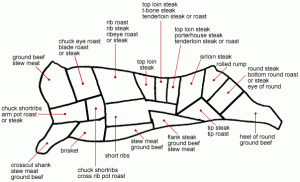
BTW, if you are interested in learning more about Korean 100+ beef cuts vs US beef cuts, check out my Know your Beef Cut! post.
Back to pork..so as far as the primal cuts go, there is almost a one-to-one correlation between Korean pork cuts and US pork cuts. But again, Korean pork cuts are further divided into more detailed smaller cuts.
First, here’s the US pork cut diagram from www.clovergarden.com:

And below is a diagram that shows all the different Korean Pork cuts within each US primal pork cut. Believe it or not, I drew this by hand!!! I just could not find one that properly showed all the different cuts in the right location so after searching the internet for many hours, I decided I would spend even more hours to draw the Korean pork diagram myself…why I do these things, I don’t know.. 🙂
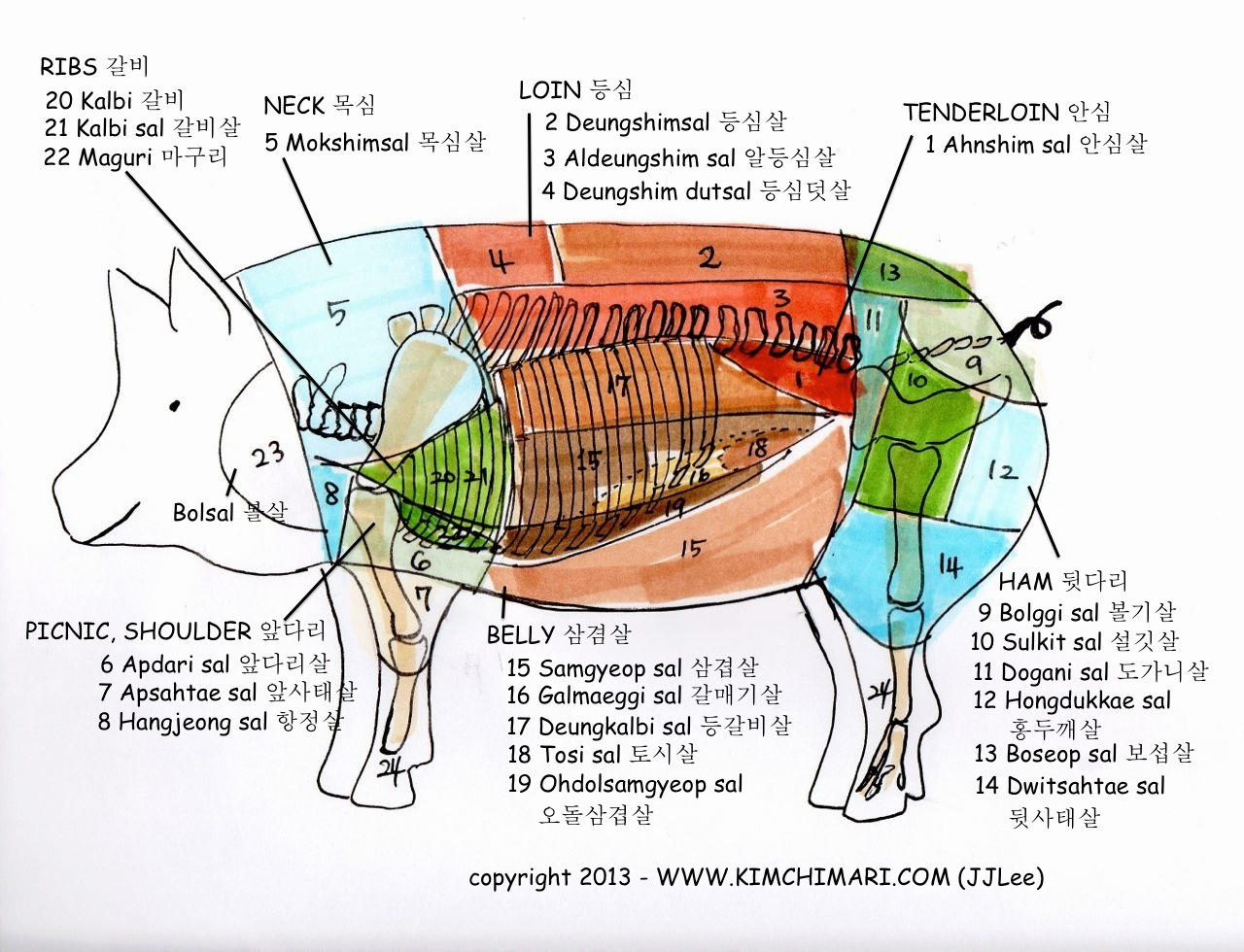
Now, let’s go over each of the 22 Korean cuts of pork along with applicable US cuts.
| Primal Cut | Korean | US |
| Tenderloin (Ahnshim 안심) | 1. Ahnshim sal(안심살) | Tenderloin |
| Loin (Deungshim 등심) | 2. Deungshim sal(등심살) | Boneless loin |
| 3. Al deungshim sal (알등심살) | Boneless loin (center loin, closer to spine) | |
| 4. Deungshim dut sal or Gabrit saal(등심덧살, 가브릿살) | Blade end loin (front top loin) | |
| Butt/Boston Butt (Mokshim목심) | 5. Mokshim sal (목심살) | Butt |
| Picnic, Shoulder (Apdari 앞다리) | 6. Apdari sal (앞다리살) | Boneless picnic (shoulder) |
| 7. Apsahtae saal (앞사태살) | Boneless picnic (more leg than shoulder) | |
| 8. Hangjeong sal (항정살) | Jowl/Neck (part picnic, part butt) | |
| Leg, ham (Dwitdari뒷다리) | 9. Bolggi sal (볼기살) | Butt end of ham |
| 10. Sulkit sal (설깃살) | Center part of ham (middle) | |
| 11.Dogani sal(도가니살) | Center part of ham (near loin, belly) | |
| 12. Hongdukkae sal(홍두깨살) | Center part of ham (near tail end) | |
| 13. Boseop sal (보섭살) | Rump | |
| 14. Dwitsahtae sal(뒷사태살) | Shank end of ham | |
| Belly (Samgyeop sal 삼겹살) | 15. Samgyeop sal(삼겹살) | Belly meat from rib #5,6 to end of side, ending before hind leg |
| 16. Galmaeggi sal(갈매기살) | Diaphragm | |
| 17. Deung kalbi sal(등갈비살) | Baby back ribs (from rib #5 to end) | |
| 18. Tosi sal(토시살) | End part of flap meat, near butt end | |
| 19. Ohdolsamgyeop sal(오돌삼겹살) | Rib tips (from rib #5 to end) | |
| Ribs (Kalbi 갈비) | 20. Kalbi (갈비) | Front ribs (#1-#5) |
| 21. Kalbi sal (갈비살) | Boneless rib meat (#1-#5) | |
| 22. Maguri (마구리) | Rib tips (#1-#5) | |
| Cheek (Bolsal 볼살) | 23. Bolsal (볼살) | Cheek |
Note that the cuts are not always an exact match.
- 24. Jok bal(족발) usually includes bottom part of the hock but not all. The upper part of the hock is also included in Sahtae(사태).
Here are some additional tid bits that’s worth mentioning:
- 16. Galmaeggi sal(갈매기살) – This is the diaphragm of the pig. Koreans consider this cut a delicacy and restaurants advertise this cut as their featured menu. Because this is the diaphragm, it can get exposed to the pig’s innards and can be contaminated. Careful cleaning and preparation is important when eating this cut.
- 18. Tosi sal(토시살) – This cut is separated from Galmaeggi sal and is so small (only about 3 oz per pig) that it’s often sold as part of Galmaeggi sal. Some people love the taste of Tosi sal because of it has more intense flavor and chewy texture than Galmaeggi sal.
Finally, here is a list of which cuts work best for each cooking method:
Soups(국 Guk or 탕 Tang)
- shoulder, picnic(apdari sal, apsahtae sal)
- center cut of ham(seolkit sal, dogani sal)
- rib tips(maguri)
Stew/Hotpot (찌게 Jjigae/전골 Jeongol)
- center cut of ham(dogani sal)
- butt(mokshim sal)
Grilling (구이 Gui)
Koreans are masters at grilling all kinds of tough, chewy meat by slicing them thinly against the grain.
- basically all cuts except the Loin area are popular for grilling. Most popular are slices from the Belly(samgyeop sal) and Tenderloin(ahnshim sal).
marinated bulgogi recommended:
- loin(deungshim sal)
- butt(mokshim sal)
- butt end of ham(bolggi sal)
- rump(boseop sal)
- leg of ham(dwitsahtae sal)
Braised (Jjim 찜, Jorim 조림)
- tenderloin(ahnshim sal)
- picnic(apdari sal)
- rump, leg, butt end of ham(boseop sal, dwitsahtae sal, bolggi sal)
- baby back ribs(deungkalbi sal)
Boiled Meat (Suyuk 수육, Pyeonyuk 편육)
- butt(mokshim sal)
- leg of ham(dwitsahtae sal)
- belly(samgyeop sal)
- rib tips(ohdolsamgyeop sal)
Sweet and Sour pork (Tangsuyuk 탕수육)
- tenderloin(ahnshim sal)
- loin(deungshim)
- center cut of ham(seolkit sal, dogani sal)
** Special appreciation to Mr.Grygus at www.clovegarden.com for granting me permission to use his chart and cut information. His site has some great information about the various cuts.
** AmazingRibs.com also was a great resource for understanding how exactly the ribs and belly parts were cut.
Hope this was helpful!!! Hope you will get to enjoy some great samgyeop sal BBQ very soon!
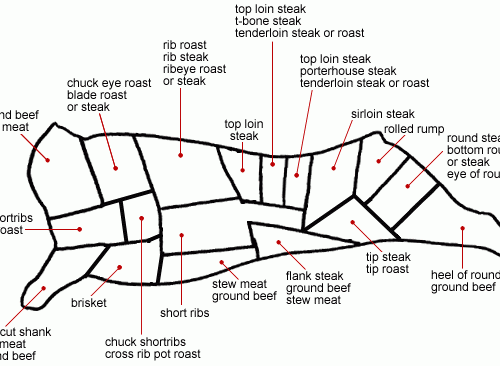
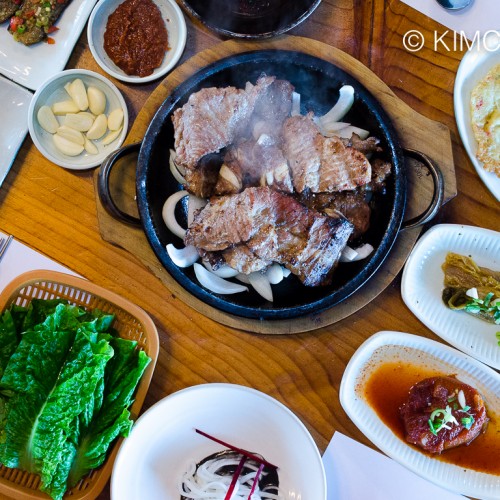
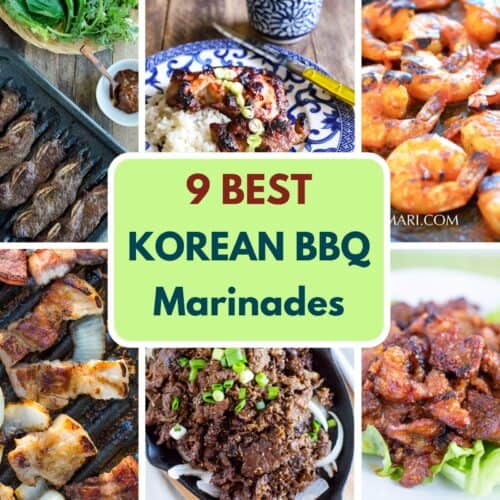
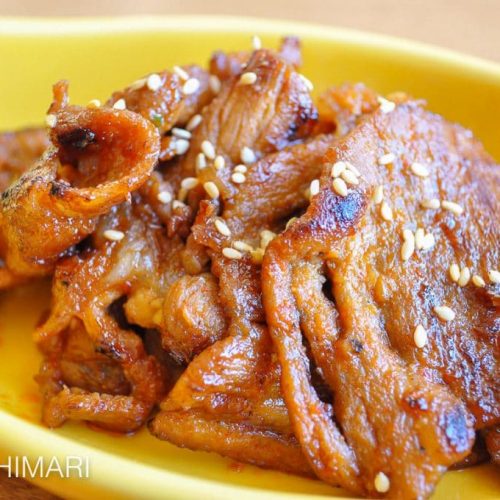
















Absolutely love this post and the one breaking down cow bits. Very valuable information. Coming from a person who is a little better than clueless about these things. Per your recommendation I’ll try jowl & diaphragm bbq.
Hi Minh, Pork Jowl is my favorite cut for bbq!! Thank you.
Could you recommend any pork butcher shop in Seoul? have been trying to find them for so long… Thank you so muchh
Hi Flukeki, hmm.. Seoul is so big and I’m not sure which area you live..I am afraid I don’t have any personal favorite shop since many butcher shops have disappeared but I did buy some great quality Jeju pork at Department stores like Shinsegae or AK Plaza where I used to shop mostly. They are expensive but I find they are more trustworthy than most shops. Emart is OK too not the best though. Sorry I can’t be of more help. Thanks
I have returned to Korea and again live in Seoul. The best place to purchase fresh, ( I mean fresh) is at the Majang Meat Market. It is several blocks big and offer almost any kind /cut of pork and beef including Hanwoo (Best) beef. Look on Seoul travel sites for directions. Well worth it.
Hello,
I live in Korea and want to make pulled pork in my slow cooker. Which Korean cut(s) should I use? Thanks
HI Holland, I believe pork butts or picinic shoulders are used for pulled pork. If this is the case, mokshimsal 목심살 is what you want. Good luck!
It worked beautifully. Thanks!
That’s so good to hear. Thank you so much for letting me know. Take care,
Thank you sooo much for this. I have access to an excellent Pork Butcher here in Portland and they said they can do any cuts as long as you tell them what you want. So it’s kinda hard to know what you want when you only know what you ate and not where on the pig it came from. I can now tell them exactly what I want and show them a picture 🙂
Is this the book on Butchery: 백종원의 육? When I go out to eat with my Korean friends they like 오겹살 over 삼겹살, but I don’t know what is the difference. Is it just because the 5 layer Belly includes the skin? There’s a chain on the east coast called Honey Pig and they also have 대패 삼겹살 on the menu. It looks like the belly was rolled and then sliced thinly, what’s the difference between that and normal 삼겹살?
Now that it is BBQ season I would like to get some different cuts to try out, what would you recommend? Also for 탕수육 what are the differences between the flavors for those 3 different cuts?
Hello Nate – Yes, 백종원의 육 is a book on butchery. I have one – really expensive though. In terms of the cut, there is no difference between 오겹살 and 삼겹살 except, you are correct, 오겹살 includes the skin layer, making it 5 layers. Some say, the pig has to be less than 60kg for the 오겹살 to be of good quality and not too much fat. But not totally sure on that. Oh, I have been to Honey Pig – in Virginia. Good stuff. So 대패 삼겹살 is something created by 백선생. I actually watched his interview and he said that in order to lure guests, he came up with the idea of freezing the belly and cutting it paper thin with a slicer. And when you do that, it comes out curly which has better presentation, takes up more room but much less meat. 😉 So no difference, just that it is cut thinly and it rolls up by itself when it is frozen. (you can only cut it paper thin when the meat is soft frozen).
As you may already know, tenderloin is the always the most tender cut of the animal with almost no fat. Loin is next with little fat and also tender but not as much tenderloin. The center cut of the ham would be a little more chewy but still little fat. So it depends on what kind of texture you like. Some like their meat more chewy and some just love melt-in-your mouth tender. When using the ham area cuts, you should cut in small pieces to make sure it is not too tough.
For BBQ, if you are looking to do Korean style and you can get your butcher to cut them for you – I would try cut 8 and 16 on my chart. They are some of the most popular cuts in Korea if you really know how to eat pork. Good luck!
Hello. Thank you for explaining pork words in Korean. I am working for a pork trading company. I would like to tell you Galmaegisal. That is not a part of belly. It’s DIAPHRAGMA!. By the way, I really appreciate this post. This post is helpful for me! Thank you.
And Hangjeong is also Jowl. Bolsal is Cheek meat.
Got it. Will clarify that too. Thanks so much again and best of luck on your job! BTW, curious, do you export Korean pork? or do you just need it to label your meat for foreigners?
Hello! Thank you SO much for pointing that out. I did check again and you are right. It’s some time ago I did this and when I did it, I had to gather the info from many different sources. So I don’t remember why I did what I did but recently I bought Baekjongwon’s book on butchery and have been meaning to go back and check but never got around to it. Will definitely correct it! And I’m glad it’s helpful for your work. Good luck!